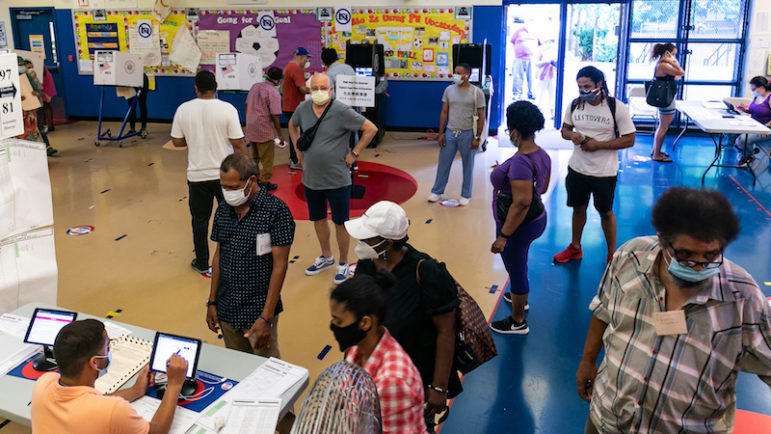‘In New York City, where more than 3 million people voted in 2020, voters under 30 comprised the largest uptick in turnout of any age group.’

Adi Talwar
Half of Americans ages 18-29 voted in the 2020 general election, one of the highest youth voting rates in decades, up 11 points from 2016 (from 39 to 50 percent). There are many reasons for this historic increase, with the COVID-19 pandemic at the top of the list of issues for young voters, followed by racism and climate change.
The 18-24 age group in particular—“Gen Z”—had the largest rise in turnout. Many took part in the summer’s political and racial-justice protests, and it appears that their activism led to their voting in larger numbers. This generation understands that their lives and the lives of future generations depend not only on how they vote today, but also on their being civically engaged in their local and global communities. Voting is a way to make their voices heard and have an impact on policies.
In New York City, where more than 3 million people voted in 2020, voters under 30 comprised the largest uptick in turnout of any age group, according to a report from the New York City Campaign Finance Board. These young voters went to the polls at a higher rate in the 2020 general election than they have in nearly a decade. More than 59.3 percent of registered voters aged 18-29 voted, up 3.4 percent from 2016, and 4.2 percent from 2012.
Despite these promising signs, youth voter turnout nationwide is nearly 25 percent lower than voter turnout among voters 65 and older; clearly, there is still work to be done to engage and educate young voters. Educating for American Democracy (EAD) is one example of this work. It is “an unprecedented effort that convened a diverse and cross-ideological group of scholars and educators to create a Roadmap to Educating for American Democracy—guidance and an inquiry framework that states, local school districts, and educators can use to transform teaching of history and civics to meet the needs of a diverse 21st century K–12 student body.” The authors write: “In recent decades, we as a nation have failed to prepare young Americans for self-government, leaving the world’s oldest democracy in grave danger.”
As stated by CIRCLE, the Center for Information & Research on Civic Learning and Engagement at Tufts University, “Election systems and the preparation many young people receive (or fail to receive) to become informed voters are inadequate, leading to significant variations in voting rates by race/ethnicity, educational attainment, and other socioeconomic and demographic factors. When certain groups have more say in what happens in their communities and the nation, we fall short of the premise of our democracy, which relies on participation … broadening youth voting is one of the vital tasks in strengthening democracy.”
The nonprofit that I co-founded in 2018, MyVote Project (MVP), is ideally positioned, with solid successes over the past three years, to address the urgent need for comprehensive, nonpartisan, easily-accessible information about candidates and their stands on policy issues so voters can make informed decisions at the ballot box.
Powered by a network of nearly 300 student volunteers, MVP combines old-school community outreach with digital-themed voter-engagement techniques using social media, virtual convenings, and an interactive website designed to inform, not influence, voters. This June 2021, in time for the New York primary election, MVP relaunched its website, providing nonpartisan information about candidates for local offices in select cities and towns in eight states, including New York.
Voters can access the policy positions of candidates without having to research each one. By simply typing in their zip codes a month before elections, users view policies relevant to their communities and platforms for candidates running in their jurisdictions. The candidate information is curated by student volunteers spread across the country, using a standardized process to research candidates and provide only information pulled from candidates’ own words on their websites and social media. So far, volunteers have researched over 15,000 candidates in cities and states across the country, including New York.
To support this work, we co-hosted three virtual forums attended by approximately 200 people in The Bronx, Brooklyn, Queens, Staten Island, and Manhattan, where local candidates for New York City Council were invited to share their platforms and Rank the Vote offered voter education training. Other partners included YVote and VoteRiders.
Meera Nagulendran is our lead student volunteer for New York state. She’s a junior at Baruch College Campus High School in Manhattan who joined MyVote Project last year at age 15. Her mother, Kavitha Mathew, is on her local community board, and Meera cannot wait until she’s old enough to follow in her mother’s path. She leads events and on-the-ground engagement in New York City and co-leads our Coalitions team to connect us with partners.
I’m proud to be part of the movement to transform American democracy by getting educated and informed young people to the polls. For those too young to vote, this is the beginning of their civic education. Our volunteers will be on the ground throughout New York City, handing out flyers, putting up posters with our QR code for easy access to our website, and going to locations offering early voting, as well as to polls on Election Day, to encourage voters to go to our website and read about candidates.
MyVote Project is building leaders within communities to create a more informed electorate whose interests are represented by their candidates. We currently cover communities where our volunteers live. Since many of them can’t vote yet, this volunteer work gives them a voice. Our hope next year is to do expansive coverage for each primary election where we have a presence in the state.
Gita Stulberg is the co-founder of MyVote Project, as well as a community organizer and political strategist. She got her start in the world of politics as a pollster for Blum and Weprin Associates.








